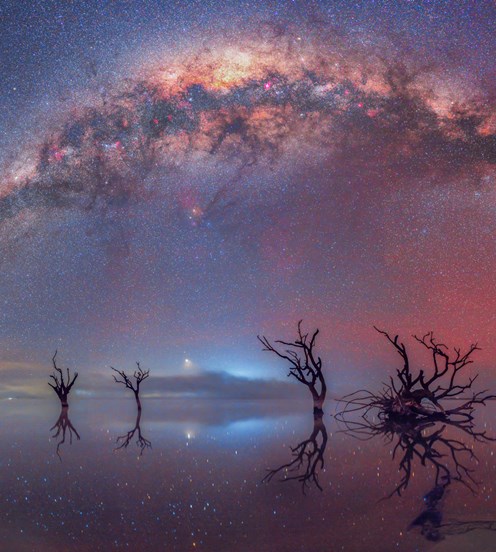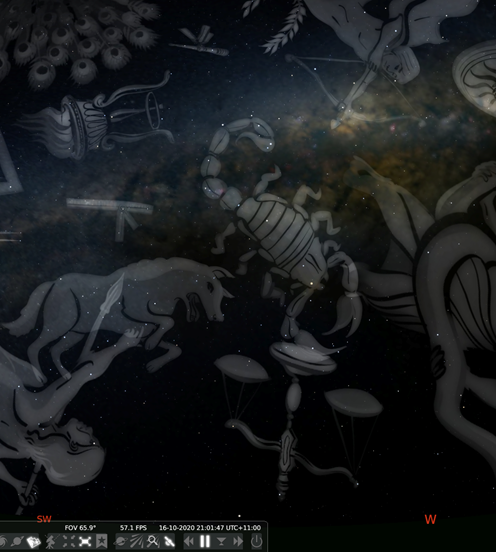
Planetarium now open
Melbourne Planetarium has shows every day during the summer holidays. Take a journey out into the solar system, explore our nearest neighbour the moon, or delve into the mystery and power of black holes.

Melbourne Planetarium has shows every day during the summer holidays. Take a journey out into the solar system, explore our nearest neighbour the moon, or delve into the mystery and power of black holes.

Enjoy a gallery of the latest stunning images as judged by renowned astrophotographer Dr David Malin. This exhibition of beauty and wonder runs until 18th April 2021.

Log on and join in as we discover the night sky and learn about our place in the universe. In February and March there will be special astronomy webinars for adults, families or early learners.
NASA's Perseverance Rover with helicopter-drone, China's Tianwen1 orbiter/lander/rover, and Emirates Hope orbiter are all set to arrive at the Red Planet in February.
Total Lunar Eclipse is coming up for Australia, New Zealand, Papua New Guinea and the Pacific on May 26. The moon will pass entirely into Earth’s darkest shadow, the umbra.
New launch target is October 31 for this ambitious infrared detector to sit 1.5 million km from Earth at the Lagrange L2 Point. Unlike the Hubble Space Telescope in Earth orbit, this telescope in deep space cannot be visited for servicing or upgrades.
Other 2021 missions expected include India's Gaganyaan test launch to Earth orbit and Chandrayaan probe to the Lunar South Pole early in the year, as well as NASA's xenon-thrustered DART impactor to asteroid Didymos in July.
| Date | Rise / Set / Day Length / Solar Noon* |
|---|---|
| Fri 1 | 6.01am / 8.45pm / 14.43 hrs / 1.23pm |
| Mon 11 | 6.10am / 8.45pm / 14.34 hrs / 1.27pm |
| Thu 21 | 6.21am / 8.41pm / 14.19 hrs / 1.31pm |
| Sun 31 | 6.32am / 8.33pm / 14.01 hrs / 1.33pm |
* The sun is at its highest crossing the meridian or local longitude.
| Phase | Date |
|---|---|
| Third Quarter | Wednesday 6 |
| New Moon | Wednesday 13 |
| First Quarter | Thursday 12 |
| Full Moon | Friday 29 |
Moon perigee (closest to Earth) will be 367,387km on Sunday 10.
Moon apogee (furthest from Earth) will be 404,360km on Friday 22.
Earth will reach perihelion (closest to Sun) on January 3rd at 147,093,163 million km. Due to our planet’s elliptical orbit it will be 5 million km closer than aphelion (furthest from Sun) which will occur this year on July 6th.
Mercury is a daytime object this month and not visible being behind or very close to the sun.
Venus this month will rise in the east about 5am and, as the ’morning star’, it will be visible for an hour before fading in the dawn light.
Mars is clearly seen as an orange object in the north-west from 9:15pm before setting around 1am the next morning.
Jupiter is now setting in the south-west shortly after sunset and will be close to and then behind the sun this month.
Saturn follows Jupiter in setting after sunset and will also move behind the sun.
The month’s most active shower, the Quadrantids, is a Northern Hemisphere shower peaking on the 4th. In the Southern Hemisphere is Eta Carinids active from 14th-27th with typically faint meteors of only 2 or 3 per hour at its peak on the 21st. This shower is centred near the faint star Eta Carina located near the Southern Cross. It is high in the south midnight to dawn, an ideal time for meteor observing.
ISS orbits every 90 minutes at an average distance of 400 km appearing like a bright star moving slowly across the night sky. Here are some of the brightest passes expected this month over Melbourne and Central Victoria:
Evening
Morning
For ISS passes and satellites in orbit visit www.heavens-above.com.
Summer after dark is a great time for stargazing and constellation spotting, especially if looking south, east and north. In a dark location you can see the broad band of stars and dark regions of our Milky Way Galaxy arcing across the entire sky.
The Southern Cross and the nearby Pointers (Alpha and Beta Centaurus) are easy to spot low to the horizon in early evening. The dark dust clouds along the Milky Way form the giant emu Tchingal in some First Peoples’ stories. Its head is the dark dust cloud known as the Coal Sack, while the adjacent Southern Cross is the possum Bunya sitting high in a tree.
High in the south on their own are our two neighbouring galaxies the Large and Small Magellanic Clouds (160,000 and 200,000 light years away respectively). From the southern hemisphere they are a treat and always visible in our skies which is not the case for most of the northern hemisphere.
Sirius, the brightest star at night and a binary star system, is half way up from the horizon. Every culture seems to have recognised it in stories or for marking calendar events. It is the head of Canis Major (Greater Dog), and also the head of Warepil, a wedge-tailed eagle, one of the most important figures for aboriginal astronomy.
The three bright stars forming a short line is the asterism known as The Saucepan or Pot. They also form the belt of Orion the hunter who lies upside down from our southern hemisphere perspective (as does Canis Major). Orion’s sword sheath, or the handle of the Saucepan, contains the spectacular Orion Nebula - the birthplace of new stars. Above left is the blue supergiant star Rigel (one of his feet) and below right is the red supergiant star Betelgeuse (one of his shoulders).
Look for the wedge or inverted ‘V’ that is the head of Taurus, the Bull, with the red giant star Aldebaran at its lower right corner. To the left is the beautiful Pleiades Cluster (or Seven Sisters), a group of young blue giant stars that formed together and are bound under their mutual gravity. The star cluster in many cultures represents a woman or group of women. For example, in the Boorong tradition of north-west Victoria they form the drum that Larnankurk is using as she accompanies dance and song.
Back in the north-east the head of Taurus is Gelarlec, the songman, and the centre of Orion or the Saucepan is Kulkunbulla, two young men practicing their dancing.
Explore Australia’s First Peoples’ astronomy at: aboriginalastronomy.com.au
And finally, if you like a challenge, you can also find low in the north-west a small ‘smudge’ which is the most distant object visible to the unaided eye. You will be looking at the large Andromeda Galaxy or M31 in Charles Messier’s catalogue (at 2.5 million light years). When you spot it remember that the light from its 1 trillion stars has taken 2.5 million years to reach your eyes. You will be seeing that galaxy as it was all that time ago. Light, despite being the fastest thing we know of at 300,000 km per second, takes time to travel across space. 1.3 seconds for moonlight to shine down on you. Eight minutes for the Sun’s light to reach you. About four hours for Neptune’s faint light. A little over four years from Alpha Centauri. 444 years from the Pleiades cluster. 26,000 years for starlight from our galaxy’s core. 160,000 years for the Large Magellanic Cloud. And 2.5 million years for Andromeda’s dim glow. As you gaze out at night you witness objects in their past. You are looking back in time.
1st 1801, the first asteroid, Ceres, was discovered by Giuseppi Piazzi.
2nd 1959, first detection of solar wind by Luna 1 (USSR) as it passed the moon.
4th 1958, the first satellite, Sputnik (USSR), fell back into the atmosphere and disintegrated after 11 weeks in orbit.
4th 1959, first human-made object enters heliocentric orbit, Luna 1 (USSR).
4th 1643, birth of Isaac Newton famous for studies in optics, the reflecting telescope, laws of gravitation and motion, and co-creator of calculus.
5th 2005, discovery of the most massive and second largest dwarf planet, Eris at 2,300 km diameter, by team led by Mike Brown at Palomar Observatory.
8th 1942, birth of Stephen Hawking, theoretical physicist, cosmologist and science celebrity.
11th 1787, discovery of Uranus’s first two moons, Titania and Oberon by William Herschel.
7th 1610, Galileo Galilei’s discovery of Jupiter's four largest moons: Io, Europa, Callisto and Ganymede.
16th 1969, first docking in space and first crew exchange in space between Soyuz 4 and Soyuz 5 (USSR) in Earth orbit.
18th 1916, meteorite falls onto occupied house in Baxter, Missouri (USA).
19th 2006, New Horizons spacecraft (USA) launched to Pluto for its 2015 fly-by.
23rd 2003, final communication with Pioneer 10 (USA), first interplanetary probe to Jupiter, which later left the solar system.
25th 2006, first icy-rocky planet discovered orbiting a main sequence star, a red dwarf at 21,500 light years from Earth.
27th 1967, fire in Apollo 1 (USA) command module kills crew of three in ground test at Kennedy Space Centre.
28th 1986, space shuttle Challenger (USA), the 10th shuttle flight, explodes 73 seconds after lift-off killing all seven crew and halting the program for 32 months.
31st 1961, first hominid in space, chimpanzee Ham, in Mercury-Redstone 2 (USA), who survived and lived in zoos until 1983.
31st 1958, discovery by James Van Allen of radiation belts of charged particles from the Sun that surround Earth and which now bear his name.
31st 1958, Explorer 1 the first successful American satellite launch, and first satellite to carry instruments into space.
Museums Victoria acknowledges the Wurundjeri Woi Wurrung and Boon Wurrung Bunurong peoples of the eastern Kulin Nations where we work, and First Peoples across Victoria and Australia.
First Peoples are advised that this site may contain voices, images, and names of people now passed and content of cultural significance.